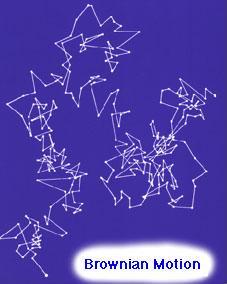 ROBERT BROWN
ROBERT BROWN

Now we fast forward to 1827 where Robert Brown, a British botanist, is observing a suspended pollen grain in water. While looking at this pollen grain underneath a microscope, he notices that it undergoes a type of random walk. The figure below depicts6 the type of random, seemingly unpredictable motion, that the suspended particle underwent.

This random motion is now referred to as BROWNIAN MOTION, but the motion itself may be easily remembered as the "Drunken Sailor Walk".
At first Brown attributed this motion to signs of life. However, when he repeated the experiment with an inorganic body he observed the same motion.

Now the phenomenon of Brownian motion has been discovered, but...
This question leads to two school of thought and a debate that lasted for 68 years!